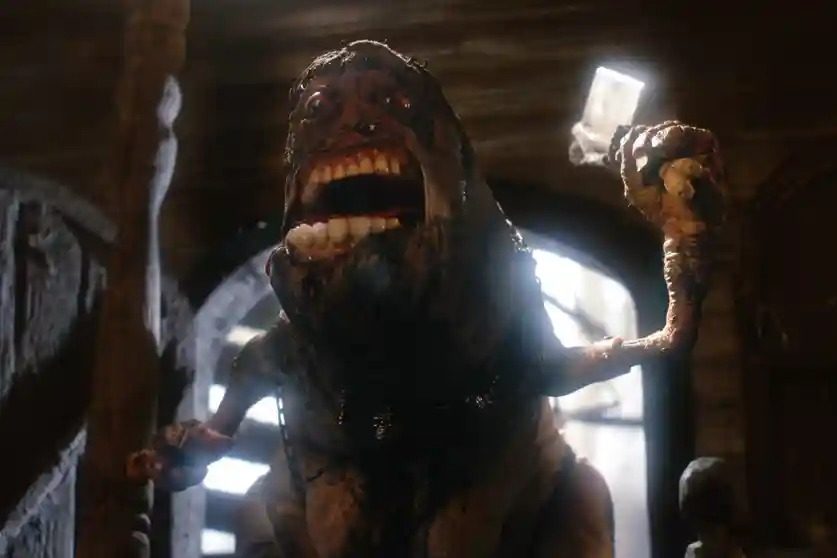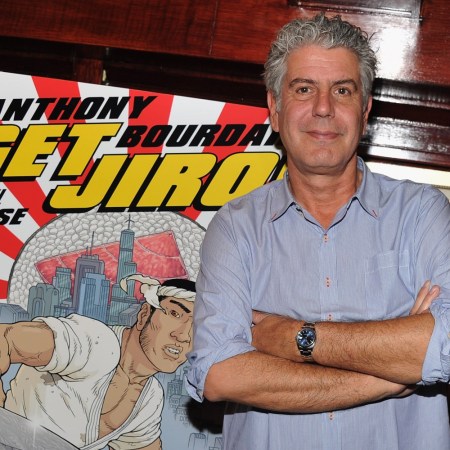In the Inferno, Dante Aligheri organized Hell into nine concentric circles more like layered rings beneath the crust of the Earth, the tiers of sin growing more egregious until we reach Satan in the ice-cold core. Sandro Botticelli painted an illustrated guide to The Divine Comedy in the late 15th century and laid out an intricate cross-section of the afterlife, its stacked echelons narrowing downward to convey the decreasing size of each realm. Phil Tippett’s new film Mad God, a stop-motion miracle that likewise maps a desolate hellscape bustling with eccentric depravities, begins with an inversion of this image. With a swell of grandiose strings and brass, a cone-shaped tower bursts onto the screen, backlit by a burning crimson sun. As storm clouds gather overhead, the camera pulls back to reveal a throng of tiny figures clarifying the colossal scale of the shot. From here, it’s all down, down, down.
Botticelli is just one in a diverse array of high-art inspirations drawn on by Tippett, a visual effects virtuoso whose long-gestating masterpiece dwarfs even his industry-standard creature work on Star Wars and Jurassic Park. Produced off and on for 30 years with an ample boost from Kickstarter, the safari of horrors samples mostly from the bustling nightmares of Hieronymous Bosch as a diving bell and its gas-masked pilot known as The Assassin descend into the bowels of a dark domain teeming with nasty fauna. He ventures through one gross, ghastly tableau after another for 84 mesmerizing minutes in a loose narrative driven less by plot than the impulse to explore and expand upon setting. (And, along the way, to show off the technological feats Tippett’s spent a good chunk of his life preparing.) At times, the vibe is not totally unlike Planet Earth, several miles down.
It would do a disservice to Tippett’s herculean efforts not to first and foremost recognize Mad God as an accomplishment of craft, an instant addition to the stop-motion canon rivaling the genius of Jan Svankmajer and picking flecks of Rankin-Bass out of its razor-sharp teeth. Labor-intensive by its stop-and-repeat nature, this style of animation depends on economy of effort; character models and sets are reused, man-hours maximized. Tippett worked as if he had nothing but time, and it shows in the staggering number of changes in scenery. Dioramas dripping with detail, each glob of goo and crag of rock fine-tuned for stomach-churning perfection, linger for no more than a few seconds in a single shot until it’s onto the next. His restless, resourceful notion of mixed media further ratchets up the atmosphere of hallucinatory unreality, the occasional live-action human (or impish gnome) interacting with crinkly abominations of clay, plaster, glue or found objects.
This isn’t to say that the film is free of content, just that it would rather develop its setting in the manner most would for character. In the same respect that New York constitutes the fifth Sex and the City gal, Hell itself is the star of the show in Mad God, a contained universe with a palpable wicked temperament. There’s a sisyphean-flavored nihilism to the constant displays of futility, like the pair of bolt-headed behemoths locked in eternal battle until their slave-driver forces them to resume shoveling what sure looks like shit. Tippett luxuriates in sadism both casual and bone-deep, anathema to even the most blackhearted horror, which at least affords us someone to invest in. The Assassin is a non-entity, disposable and replaceable, a piece of the environment that dies unceremoniously. This low valuation of life even takes a turn for the comic in a series of slapstick-adjacent sketches featuring lurching homunculi, picked off in creative and hilariously abrupt ways. Their meaningless deaths turn into a recurring punchline, and summarize the flippantly bleak “art-damaged” perspective that can only flourish in a purely independent nights-and-weekends project like this.
His decades-spanning dedication to this labor of love betrays a meaning deeper than the might of misery, however, recasting the dank carnival of grotesquerie as a negaverse fantasy of infinite possibility. The truly astonishing aspect of Tippett’s wonderland — the connection to Lewis Carroll teased with a quick shot of oversized fleas playing cards at a tea party — lies in how it allows for anything to happen, just not in a good way. Sometimes, beasties from separate pop-cultural spheres coexist in violent disharmony, pterodactyls circling overhead as red-eyed minotaurs prowl the ground below. Others, such as the gigantic head seen swallowing a never-ending stream of viscous sewage, hail from more exotic channels of imagination without discernible origins. Tippett delights in refreshing tried-and-true methods of discomfort through his design; as in Clive Barker’s Hellraiser series, the visceral element of teeth repeatedly comes into play, first in a monster with a mouthful of upside-down dentures, and then again in a dictator seen only as gnashing, blackened teeth speaking in babytalk.
The organization of power intrigues Tippett on this demonic walking tour, and contributes to the feeling that we’re seeing a brief glimpse of a history that stretches far beyond us in either direction. Remnants of bygone civilizations dot this wasteland, a row of Rhodes-sized humanoids in old-school diving suits quivering through non-stop electrocution. To whatever extent things can be said to happen in a predominantly tone-oriented film such as this, they concern the efforts of a wizard known as Last Man (portrayed by Repo Man director Alex Cox in one of the few human performances) to salvage the fate of his kind through an arcane ritual that entails sacrificing a human infant to a Grim Reaper-ish specter. An alchemist grinds the child into diamond dust that forms a new cosmos, which rapidly decays into the same cesspool as before. The film ends in obliteration, with a bomb detonating to wipe it all away. Maybe it’ll all regenerate as indifferently as before. Maybe destruction is the best we can hope for.
If that worldview smacks of callousness or cynicism, it’s tempered by the love Tippett has for his private dimension of cinema and his joy in articulating it. Taken as the angry deity suggested by the film’s title, Tippett still reserves affection for all his creations even as he tortures them in Old Testament wrath. Bulbous arachnids, animate flesh-lumps, a bandage-faced cousin of the Invisible Man who screams in the shriek of a chimpanzee — as evident in the complexity of their fabrication, Tippett cares for each of them in his own twisted fashion. In the film’s trailer, a pull-quote from former collaborator and current Lucasfilm head Kathleen Kennedy praises the “humanity and empathy” he brings to character construction. The widespread despair in his homemade fiefdom poses the same paradox facing the original God, that a ruler can somehow cause suffering out of love.
His exultation in the cinema goes one step broader than that as he takes pleasure in the sheer malleability of the moving image, like he’s trying to make every movie a weaker, saner artist would’ve made over the last 30 years at the same time. In the grisly shadow-puppet surgery nodding to animation godhead Lotte Reiniger, in the third act’s explosion of blacklit color awash in maggots, in the psychedelic freakout of shapeless abstraction that makes up the climax, Tippett spares no aesthetic expense to amaze and amuse. All the same, he’s guided by his own singular sensibility, a muse singing discordant music only he can hear. He alone knows the way through this upended underworld, and he alone can play Virgil to our curious, wide-eyed Dante. Playful and morbid, inquisitive and wise, he’s worth following into Hell and out the other side.
This article appeared in an InsideHook newsletter. Sign up for free to get more on travel, wellness, style, drinking, and culture.























